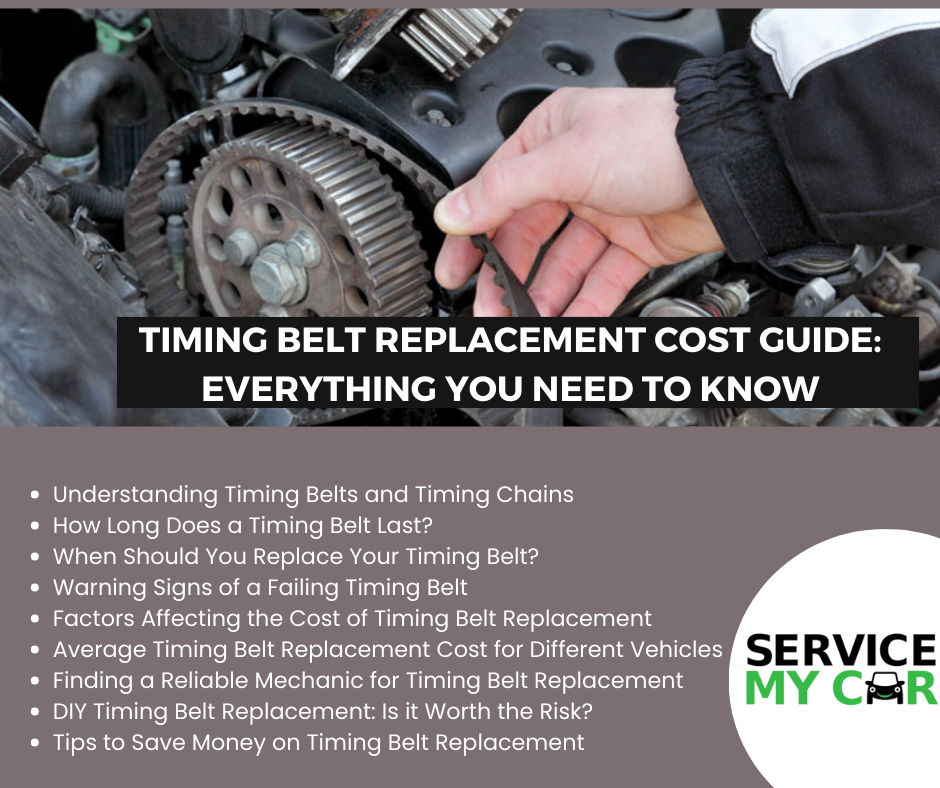Timing Belt Lifespan: What You Need to Know
A timing belt typically lasts between 60,000 to 100,000 miles, but it’s crucial to consult your car’s manual or a mechanic for exact replacement guidelines. If a timing belt fails, the engine can sustain extensive damage, so adhere to the manufacturer’s recommended replacement intervals.
Neglecting the replacement can lead to costly repairs and inconvenience, as a broken timing belt can cause the engine to stall or fail to start. Regular maintenance and timely replacement are essential for preventing potential damage and maintaining the longevity of your vehicle.
By understanding the lifespan of your timing belt and adhering to replacement guidelines, you can ensure the smooth functioning of your vehicle’s engine and avoid unexpected breakdowns.

Credit: ccmhelp.co.uk
Signs Of A Worn Timing Belt
A worn timing belt can show signs like engine misfires, unusual noises, or visible wear and tear. Regular maintenance and timely replacement are essential to avoid costly engine damage. Understanding these indications can help in safeguarding your vehicle’s performance and longevity.
A timing belt is a crucial component of your car’s engine, ensuring that the camshaft and crankshaft work together harmoniously. Over time, this belt can become worn and may need to be replaced. Knowing the signs of a worn timing belt can help you avoid potential engine damage and expensive repairs. In this section, we will explore two key indications that your timing belt may be nearing the end of its lifespan: unusual engine noise and visible wear and tear.
Unusual Engine Noise
One telltale sign that your timing belt is worn is the presence of unusual engine noise. As the belt becomes worn or damaged, it can create a high-pitched squeaking or ticking sound. This noise is often most prominent during startup or acceleration. If you notice a persistent and abnormal noise coming from your engine, it is essential to have your timing belt inspected as soon as possible.
Visible Wear And Tear
Another way to detect a worn timing belt is by looking for visible signs of wear and tear. Over time, the belt can develop cracks, fraying, or missing teeth. These visual indicators often appear on the underside of the belt, which can be accessed by removing the protective cover. Additionally, you may notice signs of oil or coolant leaks near the timing belt, indicating potential damage. Regular inspections of your timing belt can help you identify any visible wear before it leads to more significant issues.
Now that you have a better understanding of the signs of a worn timing belt, you can keep an eye out for these indications and take the necessary steps to prevent engine damage or breakdown. Remember, if you notice unusual engine noise or visible wear and tear, it is crucial to consult with a professional mechanic to determine if your timing belt needs to be replaced.
Factors Affecting Timing Belt Longevity
When it comes to the lifespan of your vehicle’s timing belt, several crucial factors come into play. To ensure optimal performance and longevity, it’s essential to understand the key elements that impact the lifespan of your timing belt.
Mileage
The mileage driven by your vehicle is a significant determinant of timing belt longevity. On average, timing belts are recommended to be replaced every 60,000 to 100,000 miles. Overextending the mileage interval can lead to belt failure and severe engine damage.
Quality Of The Belt Material
The quality of the belt material is paramount in determining its lifespan. High-quality, durable materials can significantly extend the longevity of the timing belt. It’s crucial to invest in a timing belt made from robust materials to ensure reliable performance and longevity.
Importance Of Timely Replacement
A timing belt is a critical component of a car’s engine, responsible for synchronizing the rotation of the engine’s crankshaft and camshaft. A timely replacement of the timing belt is crucial to ensure the smooth and efficient operation of the engine. Ignoring the recommended replacement intervals can lead to severe consequences, resulting in costly repairs and potential engine damage.
Preventing Engine Damage
Failure to replace the timing belt at the designated intervals can lead to its wear and deterioration. This can result in the belt snapping while the engine is running, causing the camshaft to stop rotating while the crankshaft is still in motion. The valves and pistons then collide, leading to extensive and expensive engine damage.
Avoiding Costly Repairs
Timely replacement of the timing belt can help you avoid the hefty costs associated with repairing an engine that has suffered damage due to a broken belt. Being proactive in replacing the timing belt as per the manufacturer’s recommendations can save you from the inconvenience and financial burden of dealing with a catastrophic engine failure.
Diy Vs. Professional Replacement
When it comes to replacing the timing belt in your vehicle, you have the option of handling the task yourself or seeking professional assistance. Both DIY replacement and professional replacement have their own set of advantages and disadvantages. Understanding these pros and cons will help you make an informed decision on which route to take to ensure the longevity and performance of your timing belt.
Pros And Cons Of Diy Replacement
While it may be tempting to save some money and replace your timing belt on your own, it is important to consider the associated risks and challenges. Here are the pros and cons of DIY replacement:
| Pros | Cons |
|---|---|
|
|
Benefits Of Professional Replacement
On the other hand, opting for professional replacement ensures that the job is carried out by experienced technicians who have the necessary expertise and equipment. Here are the key benefits of choosing professional replacement:
- Expertise: Professional technicians have undergone extensive training and have the necessary knowledge to carry out the replacement correctly.
- Efficiency: Professionals are equipped with the right tools and resources, allowing them to complete the replacement quickly and efficiently.
- Guarantee and Warranty: Reputable professionals provide a warranty on their work, offering you peace of mind in case any issues arise in the future.
- Safety: Professionals are well-versed in safety protocols, reducing the risk of mistakes or accidents during the replacement process.
Ultimately, choosing between DIY and professional replacement depends on your comfort level with vehicle maintenance and the complexity of the specific task. If you have the necessary skills and experience, along with the time and resources to execute the replacement correctly, DIY may be a viable option. However, if you prefer a hassle-free and reliable experience, professional replacement is the way to go.
General Maintenance Tips For Timing Belts
Timing belts are a crucial component of your vehicle, and knowing how long they typically last can help you plan for maintenance. Understanding the lifespan of timing belts will allow you to schedule regular inspections and replacements, ensuring the smooth operation of your engine and preventing costly repairs.
Regular Inspections
Regular inspections help detect any potential issues early on.
Following Manufacturer Guidelines
Following manufacturer guidelines ensures proper care for your timing belt.

Credit: resource-center.meineke.com

Credit: medium.com
Frequently Asked Questions For Timing Belt Lifespan: What You Need To Know
How Long Do Timing Belts Actually Last?
Timing belts usually last between 60,000 to 100,000 miles, or about 7-10 years. Regular maintenance and inspection can help determine the exact lifespan for your specific vehicle.
Are There Warning Signs Before A Timing Belt Breaks?
Yes, warning signs before a timing belt breaks include engine misfires, unusual noises, and visible wear on the belt. Regular inspection can help prevent sudden failure.
Can A Timing Belt Last 200 000 Miles?
Yes, a timing belt can last up to 200,000 miles with proper maintenance and regular inspections. It is important to follow manufacturer recommendations and replace the timing belt within the suggested mileage range to avoid any potential damage to the engine.
How Do I Know When My Timing Belt Needs Replacing?
You should replace your timing belt every 60,000 to 100,000 miles or as per manufacturer’s recommendations. Signs of wear include engine misfires, excessive noise, or visible cracks.
Conclusion
Understanding the lifespan of a timing belt is essential for maintaining the longevity and performance of your vehicle. Regular inspections and replacements at the recommended intervals are crucial to avoid costly damages and potential breakdowns. By staying proactive and knowledgeable about this vital component, you can ensure a smooth and worry-free driving experience.
Don’t forget, your timing belt is not something to overlook or underestimate its importance!

